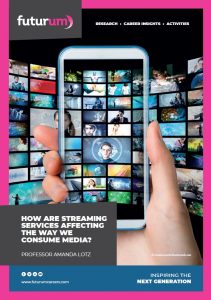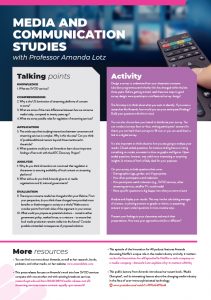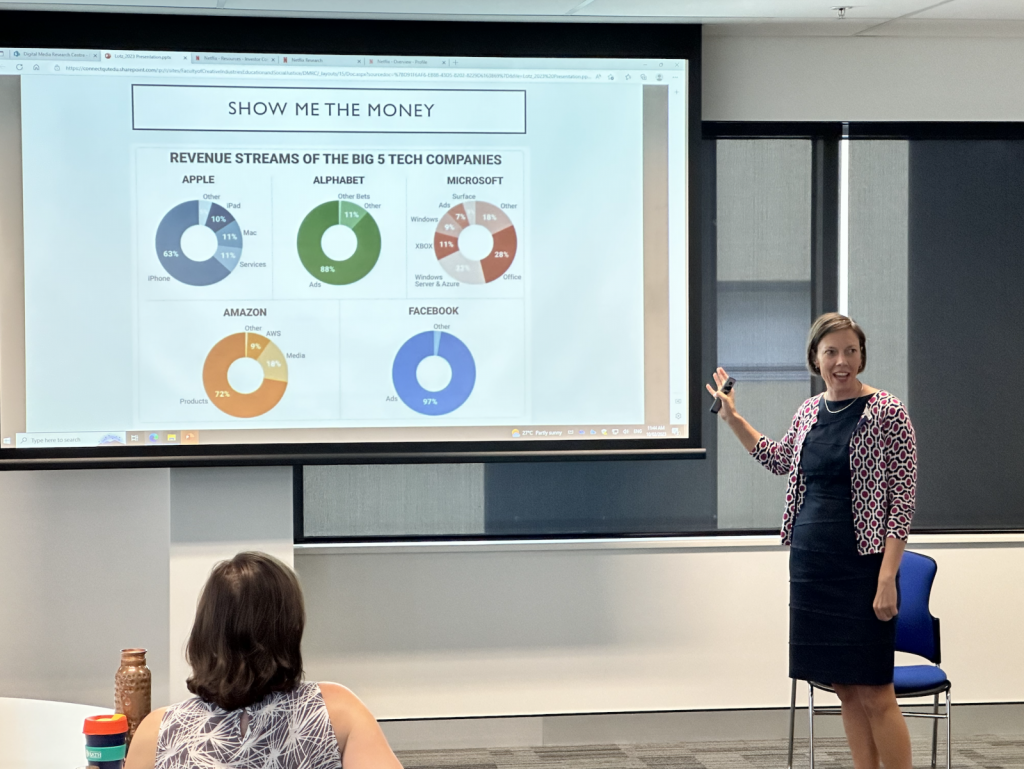How are streaming services affecting the way we consume media?
Subscription video on demand (SVOD) platforms, such as Netflix, have grown to become a core way that we watch films and television. The amount of choice we have over what to watch and when to watch it is unparalleled in the history of media, but also raises questions about what this means for screen industries and local production. Professor Amanda Lotz, at Queensland University of Technology, Australia, is scrutinising what these changes mean for markets and for us as consumers.
TALK LIKE A MEDIA AND COMMUNICATIONS SPECIALIST
Broadcast — a means of sending a signal over the airwaves using the electromagnetic spectrum (not cable, satellite or the internet)
Competition — when two or more organisations or people are aiming to establish superiority over the other
Complementary — when two or more products or services complement other products/services. For example, while Netflix and Amazon Prime offer similar streaming services, they have different attributes that complement rather than compete against each other. See this article in Forbes: www.forbes.com/sites/greatspeculations/2017/06/01/netflix-and-amazon-competitors-orcomplementary/
Market — the ‘place’ for transactions of goods and services
Policy — a proposed course of action, typically by a government
Regulation — a rule made and enforced by an authority, typically a government
Streaming — the technology of transmitting audio and video files in a continuous flow over a wired or wireless internet connection
Subscription on demand (SVOD) — services where the consumer pays a regular (usually monthly) fee to access as much content as they wish within a particular platform. Well-known SVOD services include Netflix, Amazon Prime Video and Disney+
Television has changed dramatically within its relatively short history. For many years, only a small number of channels within your country were available to watch. This was then succeeded by satellite and cable television, which opened up a much wider array of channels, including from other parts of the world. Then, in recent years, we have seen the rise of streaming services, which have enabled gigantic libraries of media from across the world to be instantly accessible.
These days, if we choose to pay a monthly fee, we can have unprecedented access to content from across the globe. “Our access to TV used to be tied to domestic or regional production,” says Professor Amanda Lotz, who works at Queensland University of Technology’s Digital Media Research Centre. “Nowadays, streaming services make titles from many countries available.” For many decades, TV channels principally broadcasted series or movies made within the viewer’s country, or material from other nations that had been chosen and licensed by the local broadcasters. This is no longer the case – things have changed on a variety of levels.
“Streaming services have changed the way we watch stories on the screen, and which stories we have access to,” says Amanda. “Even when we are watching TV ‘for fun’, the media we consume contributes to how we understand ourselves and the world around us.” For this reason, it is important to understand how the world of media is changing and what this means for society.
Studying streaming
Amanda’s discipline involves studying how media affect, and are affected by, global markets and the consumers within them. Streaming services make this a complicated challenge. “It is very difficult to compare the range of titles in a streaming library with a television schedule,” she says. “Also, because recommendations are personalised, it is difficult to know what titles are promoted to other viewers – making it challenging to gauge the ‘circulation power’ exerted by these services to drive viewers to watch certain things.”
Reference
https://doi.org/10.33424/FUTURUM367
Additionally, metrics such as number of subscribers or viewers of any one show or film are less useful, given people subscribe to a streaming service’s library of titles rather than any particular title. Many members of a neighborhood may access the same service but watch entirely different shows and films. “While streaming services may seem like broadcast services, there are some things that make them very different,” says Amanda. Understanding these differences and how to study them is important. As we all know, media can play a considerable role in how we understand the world, especially the parts outside our own experience, so investigating the ideas and stories that media make available is vital to understanding societal trends at large.
The Hollywood monopoly?
While streaming services may seem like an amazing way to ensure diverse content on the surface, it is important to note that virtually all the big global streaming organisations – Netflix, Disney+, Amazon Prime Video, HBO Max, to name a few – are based in the US. Hollywood has long played an outsized role in producing screen entertainment around the world, which creates concerns about its influence on the global market for a variety of reasons. For instance, Hollywood’s size and scale may stifle the production of local content, which cannot compete in terms of budget, and movies and series produced outside Hollywood often have more difficulty reaching viewers outside their country of production.
Scholars in Amanda’s field have long been concerned that this may lead to more ‘culturally similar’ media, where people are exposed to a narrower diversity of content. There are also some who worry that US dominance provides a route for the US to push particular political views in other parts of the world. While Amanda recognises these points are valid, she notes the situation is more complex. “The majority of global streaming services are US-based, and this is something that needs to be watched closely,” she says. “However, the greater access to global distribution may also diminish Hollywood’s centrality. The key is understanding that these services are part of a mixed ecosystem of content – some on SVOD, some on social media, and some on broadcast – that people are exposed to.”
The role of regulation
There is an argument that stricter regulation could help mitigate such US-focused media domination around the world. Regulation refers to how a nation’s laws and policies act to exert control over many parts of our lives. For instance, building regulations aim to ensure that new houses are safe and efficient; business regulations aim to ensure that businesses act in ethical and fair ways. For television, regulations may ensure that explicit content is only shown at certain times, or that a certain proportion of content must be locally produced.
Streaming services disrupt this landscape of regulation, as they don’t follow the normal ‘rules’ of broadcast media. “For instance, streaming services use the internet rather than the airwaves used by broadcasters,” says Amanda. “These airwaves are typically considered a public good, which has until now formed the basis of broadcast regulation.” Given that streaming services do not use airwaves and also typically span across many countries, they are proving harder to regulate, both nationally and internationally. For some people, this raises cause for concern, most notably with regards to the lack of any obligation for global streaming platforms to host content local to viewers.
Amanda thinks this complex picture makes it difficult to say whether stricter regulations to ensure access to local content for streaming services is the answer. “It’s possible that market demands may be sufficient to ensure the continued production of local content,” she says. “For example, a key reason that Netflix has been globally successful is that, unlike many other streaming services, it has a large amount of non-US content on its platform.” Lots of nations also have streaming services specifically for locally produced content, arguably a complementary – rather than competitive – service to global streamers.
The power of stories
As part of the ARC Discovery Project, Amanda’s team is now investigating in more detail how SVOD platforms affect national television markets. This will include comparing the responses of different governments around the world and the types of new regulations they are introducing. It will also look at how the production of local content and diversity are affected, and provide insights to inform policy decisions.

Amanda has authored several books exploring television and media industries.
Despite the variety of concerns about streaming platforms, Amanda believes they are improving quality of life overall. “The extensive libraries and alternative business models used by these streaming services means that they support the development of a much greater range of rich and engaging stories,” she says. “As individuals, we should think about what kinds of story we engage with and whether we might be missing out on others, but I think preferences and reasons why we engage with stories are personal decisions.”
 Professor Amanda Lotz
Professor Amanda Lotz
Digital Media Research Centre
Queensland University of Technology (QUT), Australia
Field of research: Media and Communication Studies
Research project: Investigating the impacts of global SVOD platforms on national television markets and national policy
Funder: Australian Research Council (ARC)
ABOUT MEDIA AND COMMUNICATION STUDIES
Media and communication studies is an interdisciplinary field that uses social sciences and humanities to study communication and human interactions with society.
Media is closely tied to technological development. The rise of streaming services, video-based social media platforms and interactive forms of digital communication have all only been made possible by new technologies. “Many things have changed considerably since the emergence of media studies, when our understandings, built then from norms of mass media, first developed,” says Amanda. “There is a lot of work to be done by researchers to update our theories and ideas as media constantly changes.”
Inventors and companies may not fully consider possible societal impacts of new technologies before they are rolled out. For instance, while social media has a wealth of positive effects on our ability to communicate, there is also evidence of its negative effects. It places new demands on young people. Academic study of these effects is essential for society to take appropriate action and be properly informed.
Policy and regulation often take time to catch up with technological development, which is why streaming services and social media platforms are relatively lightly regulated at present. Effective policy depends on robust evidence, which is where researchers such as Amanda come in. The research that academics like her produce is often integral to ensuring that new regulations are well considered.
Amanda also notes that beginning a career in media and communication studies opens many doors. “Media and communication degrees develop critical thinking, reading, writing, and communication skills that are useful in virtually every career,” she says.
Pathway from school to media and communication studies
• Many subjects are useful and relevant for a degree in media and communication studies. In particular, universities may like to see English, psychology or sociology.
• There are many undergraduate degrees focused on media and communication, but this is not the only route into the field. For careers within academia, an understanding of the social sciences is typically very useful. Degrees in psychology, economics or other social sciences may prove helpful in this regard.
Explore careers in media and communications
The majority of jobs in media and communications are outside academia, and include roles within the film industry, journalism, publicity, website development, and the written world. Within academia, the study of media and communications tends to draw from social science traditions such as sociology, psychology and political science.
• Media and communication studies typically involves a lot of interaction with media industries. Work experience or internships in public relations (PR), journalism or advertising are likely to come in useful.
• Careers within media and communications can vary enormously. In Australia, according to Glassdoor, average salaries within the field are around $65k per year.
Meet Amanda
Professor Amanda Lotz is a media scholar, professor and industry consultant. She leads the Transforming Media Industries research programme in QUT’s Digital Media Research Centre, and has authored several books exploring television and media industries. She has worked with a number of media organisations and with national governments to advise on the changing media landscape, and has also helped cultivate a global network of media scholars with expertise on streaming. She explains how her career arose.
“When I went to college, I thought I wanted to be a news presenter. I enrolled in introductory communication classes, but outside the classroom – in the campus TV station and on internships – I quickly learned that it wasn’t work I enjoyed. I did, however, find the material in my classes interesting.
“Until my last semester at university, I thought I would work in the TV industry or go to law school. A professor suggested I continue studying communication and media in graduate school, and I really loved it. I trained with the expectation that I would primarily teach. I never expected to have such a robust research career.
“Digital technologies are changing all the time. This has dramatically changed how the media industry operates. Keeping up with these changes can be frustrating but are also what makes it so interesting.
“Persistence is my philosophy, plus a bit of ‘fake it till you make it’. It took decades for me to truly find my voice as a writer and feel in command of my ability to identify important questions and know how to answer them.”
Amanda’s top tip
Be curious. Watch a lot and read widely (not just stuff on the web). Figure out the questions you are curious about answering.
Do you have a question for Amanda?
Write it in the comments box below and Amanda will get back to you. (Remember, researchers are very busy people, so you may have to wait a few days.)






Hello! I’m putting together a research project on the effects of SVODs on a decline in unity in community. I read here that you generally think that SVODs are improving our lives by their offering a variety of stories for us to engage in. What are your thoughts on how people are now watching tv and movies alone, rather than engaging in community while watching, causing a disconnect? Recent statistics say that about 88% of consumers binge-watch tv shows, and that of that 88%, 70% prefer to watch alone. Binge-watching in general has proven to be an unhealthy practice, but the effects are even more detrimental when viewers are spending that much time completely alone in front of a screen. Before SVODs, most people spent time together while watching tv, and before home tvs, people always spent time together watching because one had to go to a theater. I agree that having access to many different types of media is great, but do you believe that benefit outweigh everything else? Thanks!
Hi Emma, I’m curious about your sources because I haven’t seen good evidence of the phenomenon you note. Often “binge” watching is used to describe anything other than watching one episode weekly. Mostly it describes people working their way through episodes of show in the same way they’d read a book, an episode or two when they have time, not hours on end. Our representative survey of Australian adults showed it takes most a month to get through a 10 episode show. That survey also found that half of movie viewing and just under half of series viewing is done with other people.
I think people use streaming different ways at different times; it has made it easier for me to watch a show with each of my very busy teenagers, for example, or helps us when we are all available for a family movie night. At other times, I can watch shows that no one else in my house wants to watch, and the same for the others. I do find the situation now superior to when I grew up. The consequence of the old norms was that far fewer stories were told (at least in the US) – they were almost always about white people, had male leads, and people who had plenty of money. Now I find many more stories about people with all kinds of lives that face all kinds of challenges, and I appreciate seeing those stories.
With almost every new technology, a ‘moral panic’ gets created based on the bad uses assumed, but research has consistently shown humans are more complicated and the moral panic gets disproven.
Very informative